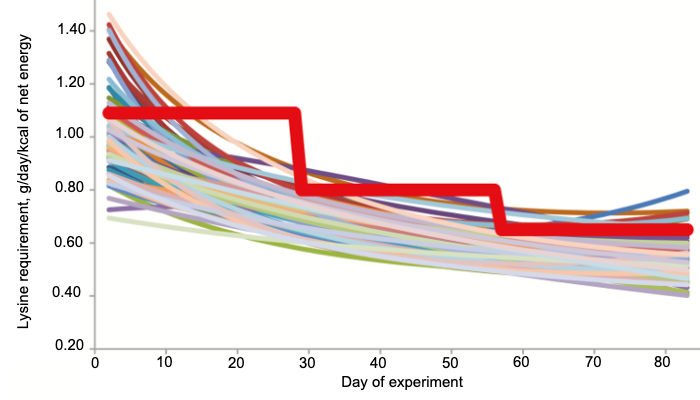Establishing an appropriate nutrition program for high-performing pigs requires consideration of genetics, nutritional needs, factors affecting these needs, and an understanding of the metabolic interaction between genotype, nutrition, reproduction, and the environment. This understanding is essential if we are to achieve both productivity in finishing and longevity in breeding sows.
Precision feeding in growing and finishing phases
In conventional production systems, pigs in the growing and finishing phases are generally housed in groups and fed the same ration for a certain period of time. Diets in this phase are usually formulated to satisfy the animal with the highest requirements in the group (Hauschild et al., 2010). Figure 1 shows the lysine requirements of individual pigs (thin colored lines) and the minimum lysine levels of pigs fed under a three-phase feeding system, according to Hauschild et al. (2010). Aymerich et al. (2020), while evaluating pigs from 28 to 63 kilograms, observed that smaller animals utilize dietary lysine more efficiently compared to animals with higher body weights.


Figure 1. Estimated ileal digestible lysine requirements of individual pigs (thin colored lines) and minimum ileal digestible lysine levels that pigs fed in a conventional three-phase group feeding system should receive (bold red line) according to Hauschild et al. (2010).
These data suggest that nutrient utilization is different among animals of the same population. In this sense, variables such as weight, time spent in the phase, age, and sex influence feed efficiency on the farm (Gaillard et al., 2020). For this reason, in conventional feeding systems, it is inevitable that there are overfed animals, harming the production system and the environment, due to the high levels of nitrogen and phosphorus excretion (Pomar et al., 2010).
Faced with this challenge, precision nutrition becomes a tool to improve the adjustment of the feed offered to animals, taking into account the variability of the nutritional needs of each individual.
Currently, some nutritional strategies are used to mitigate the effects of nutrient wastage, mainly in the growing phases. These strategies consist of increasing the number of diets offered in the same time interval and modifying their composition according to the age of the animals.
However, recent studies have indicated that this type of approach can decrease the cost of feeding by a maximum of 3% (Pomar and Remus, 2019). Whereas establishing a customized diet on a daily basis can control variations concerning time and animals, resulting in a decrease in costs of between 8% and 10% (Andretta et al., 2014, 2016a).
Efficient determination of available nutrients in feed ingredients, accurate formulation of diets, and determination of individual animal nutritional needs must be taken into account when developing precision feeding programs (Pomar et al., 2009).
Furthermore, to correctly implement the system, automatic data collection is needed along with processing of these data according to the established control strategy, as well as actions related to the control of the system- usually with the help of automatic feeding stations (Gaillard et al., 2020). In this regard, the precision feeding approach aims to provide nutrients in close to accurate proportions in relation to the animal's daily requirements, both in quantity and in the composition of the diet. This requires stipulating a dynamic diet, which meets the daily nutritional demands of the animals according to their individual characteristics.
Andretta et al. (2016b) evaluated finishing pigs and showed in their studies that by using precision nutrition, it is possible to decrease lysine intake per animal by up to 26%, and consequently reduce feed cost by approximately 10% per animal.
The same authors observed in previous work that the change from a conventional to a precision feeding system resulted in a decrease in nitrogen excretion levels by 22% and a decrease in phosphorus excretion by 27%.
These data provide evidence that precision nutrition not only improves nutrient uptake efficiency but also reduces the negative environmental impacts caused by nitrogen and phosphorus excretion (Pomar and Remus, 2019).
Precision nutrition is a tool that improves overall production efficiency. Although the implementation of this type of technology has a higher cost, several scientific results have shown that precision nutrition programs offer benefits to the animals, the environment, and above all, to the producer, as they are able to reduce nutrient wastage while maintaining performance, which optimizes production and increases profitability, especially in times of economic hardship.





